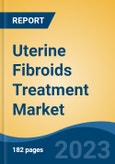Speak directly to the analyst to clarify any post sales queries you may have.
10% Free customizationThis report comes with 10% free customization, enabling you to add data that meets your specific business needs.
Key Market Drivers
Rising Prevalence of Uterine Fibroids
The rising incidence of uterine fibroids is a key driver of market growth. Uterine fibroids, benign growths in the uterus, have become increasingly common, especially among women, impacting their quality of life and reproductive health. Factors such as delayed childbearing, changing lifestyles, and obesity are contributing to the rise in fibroid diagnoses. According to the Centers for Disease Control and Prevention (CDC) in 2021, 14.6% of women aged 18 and older in the United States have undergone a hysterectomy, a common surgical treatment for uterine fibroids. As more women experience symptoms such as heavy menstrual bleeding, pelvic pain, and fertility issues, the demand for medical interventions is increasing.This growing patient population represents a substantial market opportunity for healthcare providers, pharmaceutical companies, and medical device manufacturers. In response, there has been a surge in research and development, leading to innovative treatments such as minimally invasive surgeries, pharmaceutical interventions, and novel therapies targeting the molecular mechanisms of fibroid growth.
Additionally, the rise in uterine fibroid awareness campaigns, improved access to healthcare, and enhanced patient education have made it easier for women to seek timely medical care, further driving the demand for uterine fibroid treatments. As the incidence of uterine fibroids continues to grow, there is a pressing need for innovative and patient-centric solutions.
Key Market Challenges
Limited Non-Surgical Treatment Options
A major challenge facing the global uterine fibroids treatment market is the limited availability of non-surgical alternatives. While surgical interventions have traditionally been the primary treatment option, non-surgical treatments are becoming increasingly important for women who wish to preserve fertility, reduce risks, and minimize recovery times.Current pharmaceutical treatments, such as GnRH agonists and selective progesterone receptor modulators (SPRMs), help alleviate symptoms and reduce fibroid size. However, they often come with side effects, including hot flashes, bone density loss, and mood swings, and may not offer long-term solutions since fibroids tend to regrow after treatment discontinuation.
Minimally invasive non-surgical procedures like uterine artery embolization (UAE) and focused ultrasound surgery (FUS) have gained popularity. UAE blocks blood flow to the fibroids, causing them to shrink, while FUS uses high-intensity ultrasound waves to destroy them. Though these treatments are less invasive, they are not suitable for all patients. For example, UAE may not be ideal for women planning to conceive, and FUS has limitations regarding the size and location of fibroids it can treat. Moreover, access to these procedures can be limited by cost and availability, particularly in regions with constrained healthcare resources.
Key Market Players
- Gynesonics Inc.
- Medtronic Plc.
- Boston Scientific Corporation
- Karl Storz GmbH
- Pfizer Inc.
- Abbvie Inc.
- Richard Wolf GmbH
- CooperSurgical Inc.
- Olympus Corporation
- Myovant Sciences GmbH
Report Scope
The global uterine fibroids treatment market is segmented as follows:
By Type:
- Subserosal Fibroids
- Intramural Fibroids
- Submucosal Fibroids
- Pedunculated Fibroids
By Treatment:
- Hormone Therapy
- Androgens
- Gonadotropin-Releasing Hormone Antagonists
- Uterine Artery Embolization
- Myomectomy
- Hysterectomy
By End-User:
- Hospitals & Clinics
- Ambulatory Surgical Centers
- Others
By Region:
- North America (United States, Canada, Mexico)
- Europe (France, United Kingdom, Italy, Germany, Spain)
- Asia-Pacific (China, India, Japan, Australia, South Korea)
- South America (Brazil, Argentina, Colombia)
- Middle East & Africa (South Africa, Saudi Arabia, UAE)
Competitive Landscape
The report includes detailed company profiles of major players in the global uterine fibroids treatment market.Available Customizations
TechSci Research offers the following customizations to the global uterine fibroids treatment market report:
- Detailed analysis and profiling of additional market players (up to five).
This product will be delivered within 1-3 business days.
Table of Contents
Companies Mentioned
- Gynesonics Inc.
- Medtronic Plc.
- Boston Scientific Corporation
- Karl Storz Gmbh
- Pfizer Inc.
- Abbvie Inc.
- Richard Wolf GmbH
- CooperSurgical Inc.
- Olympus Corporation
- Myovant Sciences GmbH
Table Information
| Report Attribute | Details |
|---|---|
| No. of Pages | 186 |
| Published | February 2025 |
| Forecast Period | 2024 - 2030 |
| Estimated Market Value ( USD | $ 4.74 Billion |
| Forecasted Market Value ( USD | $ 7.76 Billion |
| Compound Annual Growth Rate | 8.5% |
| Regions Covered | Global |
| No. of Companies Mentioned | 10 |









